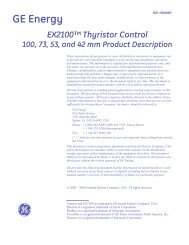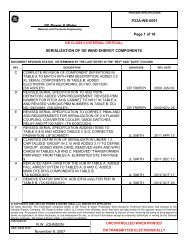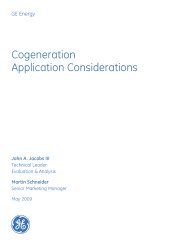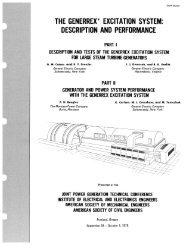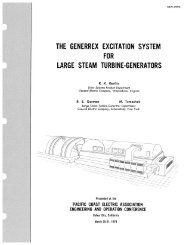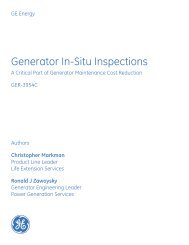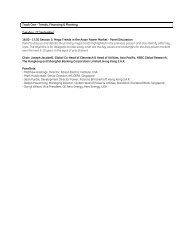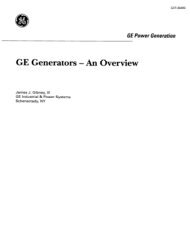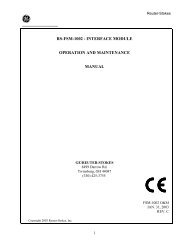GER 3568G - Dry Low NOx Combustion Systems for ... - GE Energy
GER 3568G - Dry Low NOx Combustion Systems for ... - GE Energy
GER 3568G - Dry Low NOx Combustion Systems for ... - GE Energy
You also want an ePaper? Increase the reach of your titles
YUMPU automatically turns print PDFs into web optimized ePapers that Google loves.
<strong>Dry</strong> <strong>Low</strong> NO x <strong>Combustion</strong> <strong>Systems</strong> <strong>for</strong> <strong>GE</strong> Heavy-Duty Gas Turbines<br />
premixed operation is set by the combustion<br />
reference temperature and IGV position. It typically<br />
ranges from 50% with inlet bleed heat on<br />
to 65% with inlet bleed heat off. Mode transition<br />
from premix to piloted premix or piloted<br />
premix to premix, can occur whenever the combustion<br />
reference temperature is greater than<br />
2200 F/1204 C. Optimum emissions are generated<br />
in premix mode.<br />
Tertiary Full Speed No Load (FSNL)<br />
Initiated upon a breaker open event from any<br />
load > 12.5%. Fuel is directed to the tertiary<br />
nozzle only and the unit operates in secondary<br />
FSNL mode <strong>for</strong> a minimum of 20 seconds, then<br />
transfers to lean-lean mode.<br />
Figure 16 illustrates the fuel flow scheduling associated<br />
with DLN-2 operation. Fuel staging depends<br />
on combustion reference temperature<br />
and IGV temperature control operation mode.<br />
DLN-2 Controls and Accessories<br />
The DLN-2 control system regulates the fuel distribution<br />
to the primary, secondary, tertiary and<br />
quaternary fuel system. The fuel flow distribution<br />
to each combustion fuel system is a function<br />
of combustion reference temperature and<br />
IGV temperature control mode. Diffusion,<br />
piloted premix and premix flame are established<br />
by changing the distribution of fuel flow<br />
in the combustor. The gas fuel system (Figure<br />
% of Base Load Fuel Flow<br />
100<br />
70<br />
60<br />
50<br />
40<br />
30<br />
20<br />
10<br />
0<br />
Primary<br />
Mode<br />
Primary<br />
Secondary<br />
Tertiary<br />
Quaternary<br />
<strong>Combustion</strong> Reference Temperature<br />
2135 2200<br />
Lean-Lean<br />
Mode<br />
Premix Mode<br />
2350<br />
16% Speed 100<br />
0 20 40 60 80 100<br />
% Load Typical<br />
GT24671<br />
Figure 16. Typical DLN-2 gas fuel split schedule<br />
17) consists of the gas fuel stop-ratio valve, primary<br />
gas control valve, secondary gas control<br />
valve premix splitter valve and quaternary gas<br />
control valve. The stop-ratio valve is designed to<br />
maintain a predetermined pressure at the control-valve<br />
inlet.<br />
The primary, secondary and quaternary gas<br />
control valves regulate the desired gas fuel flow<br />
delivered to the turbine in response to the fuel<br />
command from the SPEEDTRONIC controls.<br />
Figure 17. DLN-2 gas fuel system<br />
The premix splitter valve controls the fuel flow<br />
split between the secondary and tertiary fuel<br />
system.<br />
DLN-2 Emissions Per<strong>for</strong>mance<br />
Figures 18 and 19 show the emissions per<strong>for</strong>mance<br />
<strong>for</strong> a DLN-2-equipped 7FA/9FA <strong>for</strong> gas<br />
fuel and <strong>for</strong> oil fuel with water injection.<br />
DLN-2 Experience<br />
The first DLN-2 systems were placed in service<br />
at Florida Power and Light’s Martin Station with<br />
commissioning beginning in September 1993,<br />
and the first two (of four) 7FA units entered<br />
commercial service in February 1994. During<br />
commissioning, quaternary fuel was added and<br />
other combustor modifications were made to<br />
control dynamic pressure oscillations in the<br />
combustor.<br />
<strong>GE</strong> Power <strong>Systems</strong> ■ <strong><strong>GE</strong>R</strong>-<strong>3568G</strong> ■ (10/00) 11



